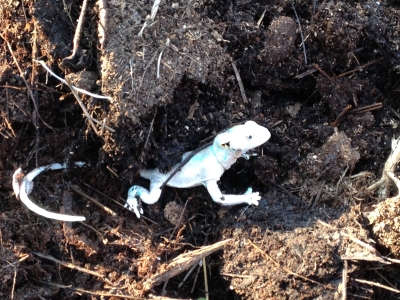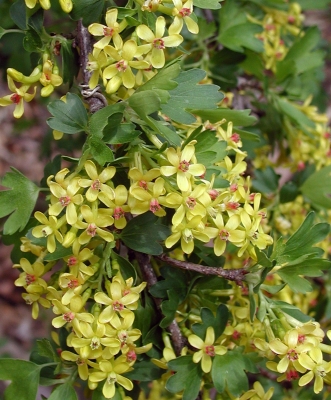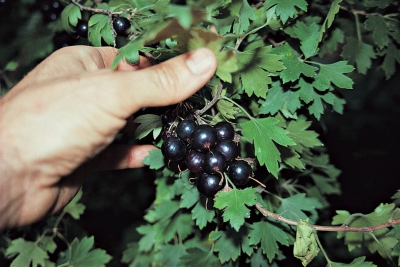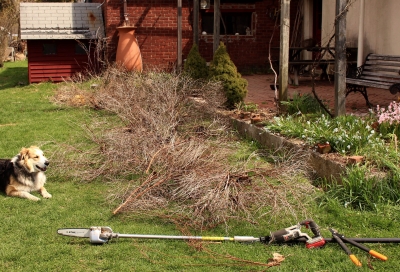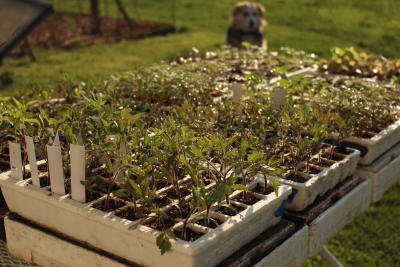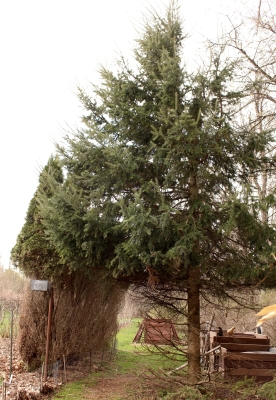EEK, A DINOSAUR IN MY COMPOST PILE!
/2 Comments/in Gardening/by Lee Reich
A Creature Not Really So Strange
One of the strangest creatures I ever found in my compost was the dinosaur that emerged today as I turned the pile. It was worse for the wear, the gash in its head probably from my machete, the “solar powered” shredder I use for stemmy compostables like corn stalks. (Think about it.) After a year in the pile’s innards, the dinosaur’s greenish, scaly skin has been bleached almost white.
I typically build compost piles through summer and into fall, then turn them the following spring. Turning, not absolutely necessary, lets me mark the piles progress and, as needed, fluff it up for aeration or sprinkle it if too dry. Many people use fencing to enclose a compost pile, which is effective as an enclosure but exposes the pile to too much drying air. My bins, made from artificial wood decking, stacked edgewise and notched together like Lincoln Logs, have solid walls which helps hold in some heat and moisture.
I should mention, at this point, that the dinosaur might, in fact be a lizard. Oh, and something else: It’s made of a rubbery plastic. This ‘saur was unearthed many years ago as I was digging up a mulberry tree. Once salvaged, it resided in one of my garden beds, where it startled people (including me, occasionally) despite its mere foot-long length. It must have hitchhiked along to the compost pile with some garden debris at the end of the season.
Good Feedstuffs Make Good Compost
Just about everything goes into the compost piles: weedy hay, garden debris, kitchen scraps, horse manure, old cotton or wool clothes, weeds, and anything else that is or was living, that is, organic. Also, some dolomitic limestone, which is rock so never was living but is “organic” in the cultural and legal sense. Dolomitic limestone adds calcium and magnesium to the finished mix, increases the alkalinity of the finished compost (to offset the naturally increasing acidity of soils here in the humid northeast), and improves its texture.
The other ingredients offer a spectrum of macro- and micronutrients to the finished compost. Carbon and nitrogen are the two feedstuffs that composting microorganisms need in greatest amounts. I don’t dwell too heavily on the ideal 15 to 1 ratio of carbon to nitrogen for a balanced feed that gets the pile heating and the compost finishing up quickly. Much depends on the size of the feedstuffs and the presence of other natural chemicals, such as natural lignins in wood shavings that slow down its decomposition irrespective of carbon to nitrogen ratios.
I do pay attention to what I put in the piles, using a thermometer, my nose, and my eyes to monitor progress. No heat, bad smells, and slow progress indicate, respectively, too much or too little moisture or too little nitrogen, too much water or nitrogen, and too much or too little moisture or too little nitrogen. It’s all good though. Adjustments can be made when turning a pile, or do nothing and wait longer. Any pile of organic materials eventually becomes compost.
Real Reptiles in the Pile
Other strange denizens, living denizens this time, of my compost piles have been black rat snakes. A few years back, I’d bump into them slithering out of the compost pile as well as coiled into the branches of a blueberry bush and, unfortunately, coming out of the chicken house, two swollen lumps in their bodies evidence of a recent two-egg meal. All-in-all the snakes are welcome for their meals of mice and rats.
I’d also come upon clusters of the snakes’ soft-shelled eggs, up to two dozen or more, as I turned the compost. After incubation in a terrarium, out slid not-very-cute baby snakes.
Decisions, Decisions
Turning compost piles provides relatively mindless relief from more thoughtful gardening such as planting decisions. Where to plant, for example, a dwarf shipova tree, an Alderman plum, and a Concorde pear? And should I risk planting out the borderline hardy Flying Dragon hardy orange (Poncirus, now named Citrus, trifoliata)?
Easier to place are the vegetables, which need to be rotated every year, never (well, almost never) grown in the same location more than once every three years. Rotation prevents overwintering, nonmobile pests from having something to attack close at hand. The vegetable garden is in two banks of beds, so I just move what’s planted in each bed two beds counterclockwise each year, two beds to get them further away from previous years location than would a one bed rotation.
Still, lettuce transplants, extra onions to be harvested as scallions, radishes, and short rows of arugula get spotted in willy nilly.
Heady Stuff, Here
May 5th: This calm, warm morning the whole yard is awash in the sweet, spicy scent wafting from yellow trumpets of clove currant (Ribes odoratum) flowers. In August, this deer, drought, cold, heat, and pest resistant plant will be covered with large, black sweet-tart currants.
DRAMATIC PRUNING & NOT-TOO-BIG ONIONS
/11 Comments/in Gardening/by Lee ReichHenry IV Method of Pruning
Deb get’s a little nervous every time a go into the garage for some pruning tools this time of year. Not because she’s afraid I might hurt myself but for what I might do to the plants. Today it was so-called “renovative pruning” of the St. Johnswort ‘Sunny Boulevard’ shrubs that line the western edge of the brick terrace. I approached the shrub with some unconventional pruning tools.
Let’s first backtrack and put everyone at ease. A shrub is a shrub because it’s shrubby; that is, it’s always growing new shoots at or near ground level rather than developing a permanent, upright trunk off which permanent limbs and new shoots grow. Some shrubs — most shrubs, in fact — get congested with too many new and older shoots rising from their base and too many old shoots that no longer perform well, in this case performance meaning a good show of flowers. An old stem can put on a good show for only so many years before becoming decrepit.
The obvious solution to the above two problems with shrubs is to, first, limit the number of new shoots arising low in or around the plant. It’s a matter of judgement for how many to leave. (Pruning is art and science, and my book, The Pruning Book, attempts to make readers better artists and scientists, when pruning, at least.) As far as those old stems, they should be cut down near ground level once they’ve overstayed their welcome.
So much for maintenance pruning. Sometimes a shrub has gotten too out of hand for all this detail work. Enter renovative pruning. It’s very easy: You just lop everything down to the ground, which is what I did to ‘Sunny Boulevard.’ I started out using a chain saw, my Stihl pole chain saw. This saw has a smaller blade and a long reach, which allowed me to get to the base of the plant without battling all the arching stems. After that, I sawed back stems arching over the hypertufa wall edge of the terrace with a Porter Cable sawzall powered by a 20 volt battery. Final cleanup was with my Fiskars Powergear lopper and Felco pruning shears. (That’s a lot of product recommendations, but I highly recommend all of them.)
All’s Well That Ends Well (in Pruning)
So what was I left with when I was done pruning? Nothing. Nada. Zip. Well, not really; the roots were still alive and in the ground. And I’m banking on those roots sending up new sprouts. And because ‘Sunny Boulevard’ is slated to start blossoming in July on buds that form on new shoots, I’m also banking on blossoms on those new shoots. Because they’re beginning growth way down at ground level, blossoming might begin a bit later than usual.
Shrubs that blossom early in the season, such as forsythia, lilac, and mockorange, form their flower buds a year before they actually open. Hence, the best time to prune these shrubs, if you want a full show of blossoms, is right after the blossoms fade. Prune them before blossoming and you cut off potential blooms.
Still, having a clean slate after a dramatic renovative pruning is appealing, sometimes even with a sacrifice of blooms. Deb is now nervous about the lilac bush, which also needs some renovation. I’m planning to do a less dramatic renovative pruning on it, and I’ll probably wait until after it blossoms.
Onions’ Size Matters
Big onions or medium-sized onions or small onions, what to grow? The choice is mine (and yours). Much depends on planting distances.
I’m opting for medium-sized onions, about 3 inches in diameter. Yesterday I set out about 250 transplants grown from seed I sowed in early February in a tub of potting soil: Three varieties: Ailsa Craig, an heirloom from 1887, for sweet, mild onions that need to be used early because they don’t store well; New York Early, a nonhybrid variety selected over the years by New York onion growers, for medium term storage; and Copra, a rock-hard, hybrid onion that stores very well, all the while maintaining some sweetness. In a 3-foot-wide bed, I planted 5 rows of onions, with about 4 inches between rows and about 4 inches between onions in each row.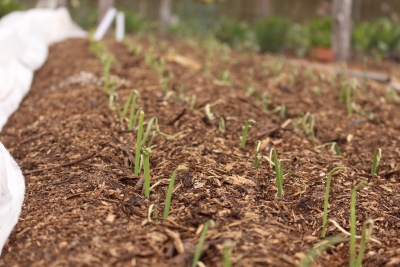 Planting distances are not the end-all for onion size. Variety also figures in; given enough space, In northern areas, such as around here, long-day varieties, which form bulbs when daylength is 14 hours or more, get largest because they grow the most leaves before bulbing begins. More leaves means bigger bulbs, which also a reason to plant as early as possible. (Note to myself: Plant onions earlier next year, in mid-April.)
Planting distances are not the end-all for onion size. Variety also figures in; given enough space, In northern areas, such as around here, long-day varieties, which form bulbs when daylength is 14 hours or more, get largest because they grow the most leaves before bulbing begins. More leaves means bigger bulbs, which also a reason to plant as early as possible. (Note to myself: Plant onions earlier next year, in mid-April.)
Even among northern varieties of onions, potential sizes vary. Ailsa Craig onions have the potential grow quite large, which is why they’re grown for exhibition at state fairs and the like. I’m banking on the close spacing keeping them from growing too big, 5 pounds or more by some accounts.
Of course, good growing conditions also make for more leaves sooner. Got that. I spread compost an inch deep over the already mellow soil and drip irrigation lines are poised to quench the plants’ thirst.
FEAST OR FAMINE
/4 Comments/in Flowers, Gardening, Pests/by Lee ReichIs Gardening Too Easy?
Control yourself, Lee! Growing seedlings this time of year is too easy. Within a single packet of seeds is the potential for a gardenful of vegetable or flower plants, even shrubs and trees. As such, a packet of seeds is relatively inexpensive.
I have envisioned delphinium in my garden, its tall, blue studded spires backed by the fence surrounding my blueberry planting. I could have just gone out and purchased a few potted delphinium plants, but I wanted a bolder effect so purchased instead a packet of seeds. Who would have thought that germination would be so good. After all, the seed germinates best when fresh and likes some cool temperatures to awaken; some people freeze the seeds in ice cubes for awhile before sowing them. I used nothing but patience, and not that much was needed.
I couldn’t bear to discard most of the seedling, so “pricked out” 24 of them into cells of my APS seedling flat.
The same thing happened with red lupines, chocolate daisies, Yellow Gem marigolds, and . . . Growing transplants is the easy part. The difficulty will be in about a month when I’m wandering around the garden, seedling flat in one hand, trowel in the other, wondering where to plant all these flowers. (This problem does not arise with growing vegetable transplants because I keep harvest records for vegetables that let me know how many plants I need of each. Could my eyes get too full or too fat on too many flowers? No.)
Damn-ping Off, No More
Raising transplants wasn’t always so easy for me. Decades ago, as a graduate student, I lived in a converted motel room which also became home to seedlings for my first garden. The shelves were lined with peat pots of sprouting chamomile (very easy), lettuce, beans, and other plants.
Thence was my abrupt introduction to “damping off,” a disease that attacks seeds and newly emerged seedlings. Imagine the disappointment of a beginning gardener (me) watching seedling stems pinch in at he soil line and topple over — the telltale symptom of damping off disease.
I soon learned that damping off was not uncommon, even among experienced gardeners. The disease is caused by any one of a few soil dwelling fungi that raise their ugly head (figuratively) given the right conditions (for them). One obvious way to try to avoid the problem is to sterilize the potting media.
Most commercial potting mixes are sterile, as were the peat pots I was using. The problem is that the culpable microbes are everywhere, just waiting to attack when conditions are just right, conditions that I unknowingly provided for them in my motel room. The peat pots were excessively moist; the air stood still; and little light entered the room — perfect for damping off development.
Nowadays, my seedlings rarely experience damping off. The plants get off to a good start at temperatures they enjoy, bathe in light in my greenhouse or sunny windows (or, in the past, cozied up very close to fluorescent bulbs), and a fan keeps the air moving. I also add sufficient perlite to my potting mixes so that excess water drains feely down and out of the mix.
Years ago, soothing brews of chamomile tea would also come to the rescue — for the seedlings, not for me. That tea hasn’t been needed for a long time. I also don’t pasteurize or sterilize my potting mixes. Beneficial microbes, from the compost in my mix, and good growing conditions have thankfully made damping off nothing more than a distant memory for me.
Oh Deer!
Bigger creatures are still an ever present nightmare. Especially deer and especially after this winter. They have sheared the greenery from nearly every evergreen they could reach here, the hollies, arborvitaes (white cedar), yews, hemlock, and junipers (red cedar).
Interesting about the yews, because the foliage is toxic to many ruminants; a mouthful will kill a horse or cow within 5 minutes. Deer, according to most reliable sources, can feed on yew without ill effect. With that said, this past winter, I did find a deer dead on the ground near my yew bushes, which had been nibbled free of their foliage.
How about the plants; how will they fare, bare. Yew tolerates all sorts of abuse in the form of pruning. Soon, new needles will start appearing along their stems. Or, if the stems are cut back, new needled shoots will soon appear. My other evergreens should also fare well. Rhododendrons and mountain laurels, which the deer left alone, also generally sprout new growth when nibbled. So any of these so-called random-branching conifers or broad-leaved evergreens can be pruned to look prettier after deer have ravaged them.
Not so with so-called whorled branching conifers, such as pines, spruces, and firs. They generally do not resprout from bare wood, so there’s not much that can be done to prettify them now. Just lop back bare branches because they’re always going to be just that: bare.
For more about pruning evergreens, and other plants, see my book, The Pruning Book.

